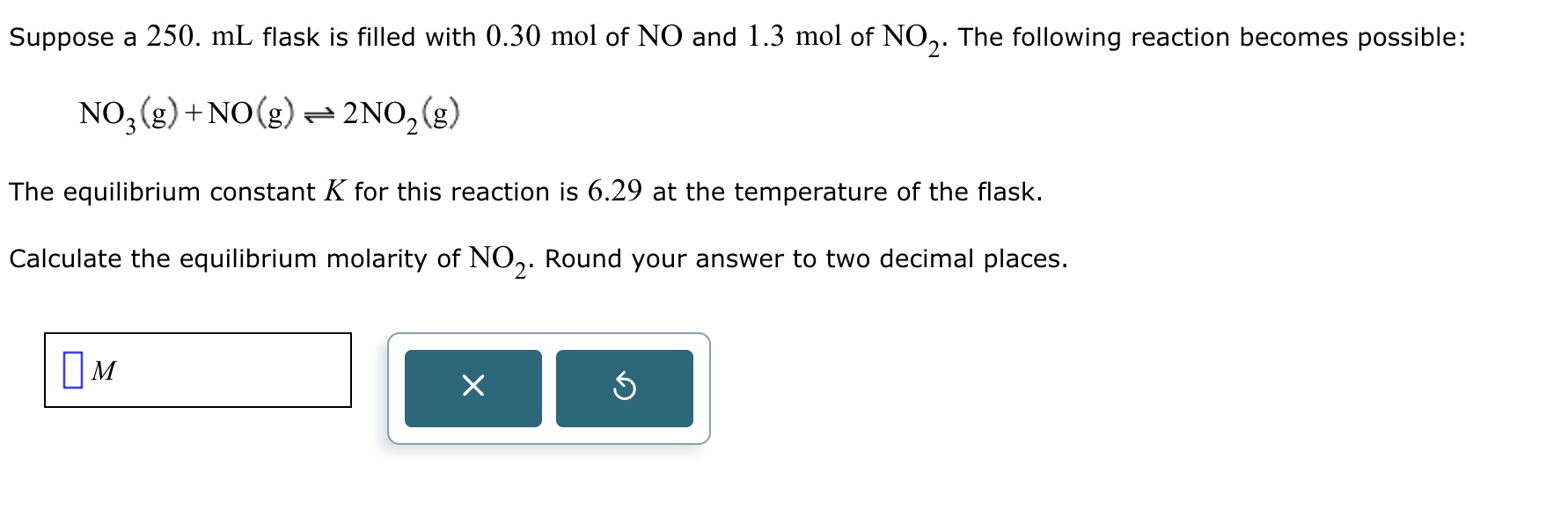Suppose a 250 mL flask is filled with 0.30 mol of NO and 1.3 mol of NO2. The following reaction becomes possible: $NO_3(g) + NO(g) \rightleftharpoons 2NO_2(g)$. The equilibrium c... Suppose a 250 mL flask is filled with 0.30 mol of NO and 1.3 mol of NO2. The following reaction becomes possible: $NO_3(g) + NO(g) \rightleftharpoons 2NO_2(g)$. The equilibrium constant K for this reaction is 6.29 at the temperature of the flask. Calculate the equilibrium molarity of NO2. Round your answer to two decimal places.

Understand the Problem
The question describes a chemical reaction at equilibrium and asks for the equilibrium molarity of NO2. We are given the initial moles of NO and NO2, the volume of the flask, and the equilibrium constant K. The strategy is to first calculate initial molarities, set up an ICE (Initial, Change, Equilibrium) table, use the equilibrium constant expression to solve for the change in concentration (x), and then calculate the equilibrium molarity of NO2.
Answer
3. 42
Answer for screen readers
3.42
Steps to Solve
- Calculate initial molarities
To find molarity, we divide the number of moles of each substance by the volume of the flask in liters.
$ [NO]_0 = \frac{0.30 \text{ mol}}{0.250 \text{ L}} = 1.2 \text{ M} $
$ [NO_2]_0 = \frac{1.3 \text{ mol}}{0.250 \text{ L}} = 5.2 \text{ M} $
- Set up the ICE table
Here's the ICE table for the reaction:
| $NO_3$ | $NO$ | $2NO_2$ | |
|---|---|---|---|
| Initial (I) | $0$ | $1.2$ | $5.2$ |
| Change (C) | $+x$ | $+x$ | $-2x$ |
| Equilibrium (E) | $x$ | $1.2+x$ | $5.2-2x$ |
- Write the equilibrium constant expression
$ K = \frac{[NO_2]^2}{[NO_3][NO]} $
$ 6.29 = \frac{(5.2-2x)^2}{x(1.2+x)} $
- Solve for x
Expanding and rearranging the equation:
$ 6.29x(1.2+x) = (5.2-2x)^2 $
$ 7.548x + 6.29x^2 = 27.04 - 20.8x + 4x^2 $
$ 2.29x^2 + 28.348x - 27.04 = 0 $
Now, we use the quadratic formula to solve for $x$:
$ x = \frac{-b \pm \sqrt{b^2 - 4ac}}{2a} $
$ x = \frac{-28.348 \pm \sqrt{(28.348)^2 - 4(2.29)(-27.04)}}{2(2.29)} $
$ x = \frac{-28.348 \pm \sqrt{803.6055 + 248.1472}}{4.58} $
$ x = \frac{-28.348 \pm \sqrt{1051.7527}}{4.58} $
$ x = \frac{-28.348 \pm 32.4307}{4.58} $
We have two possible values for $x$:
$ x_1 = \frac{-28.348 + 32.4307}{4.58} = \frac{4.0827}{4.58} = 0.8914 $ $ x_2 = \frac{-28.348 - 32.4307}{4.58} = \frac{-60.7787}{4.58} = -13.2704 $
Since $x$ represents a concentration change, it cannot be negative. Therefore, we take the positive value:
$ x = 0.8914 $
- Calculate the equilibrium molarity of $NO_2$
$ [NO_2] = 5.2 - 2x = 5.2 - 2(0.8914) = 5.2 - 1.7828 = 3.4172 \text{ M} $
- Round to two decimal places
$ [NO_2] = 3.42 \text{ M} $
3.42
More Information
The equilibrium molarity of $NO_2$ is 3.42 M. This means that at equilibrium, the concentration of $NO_2$ is 3.42 mol/L.
Tips
A common mistake is not correctly setting up the ICE table, especially the change row, with the correct signs and stoichiometric coefficients. Another frequent error is making mistakes when solving the quadratic equation. Also, forgetting to convert the volume from mL to L is another common mistake. Finally, remember to check if both roots returned by the quadratic equation are physically possible (positive concentration), and to discard any negative roots if they appear.
AI-generated content may contain errors. Please verify critical information